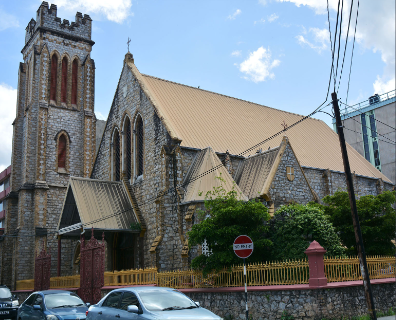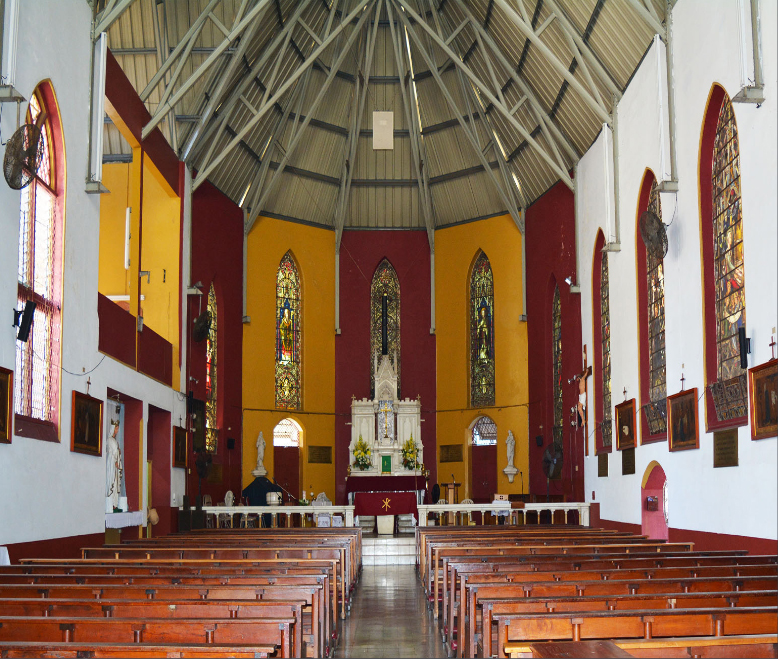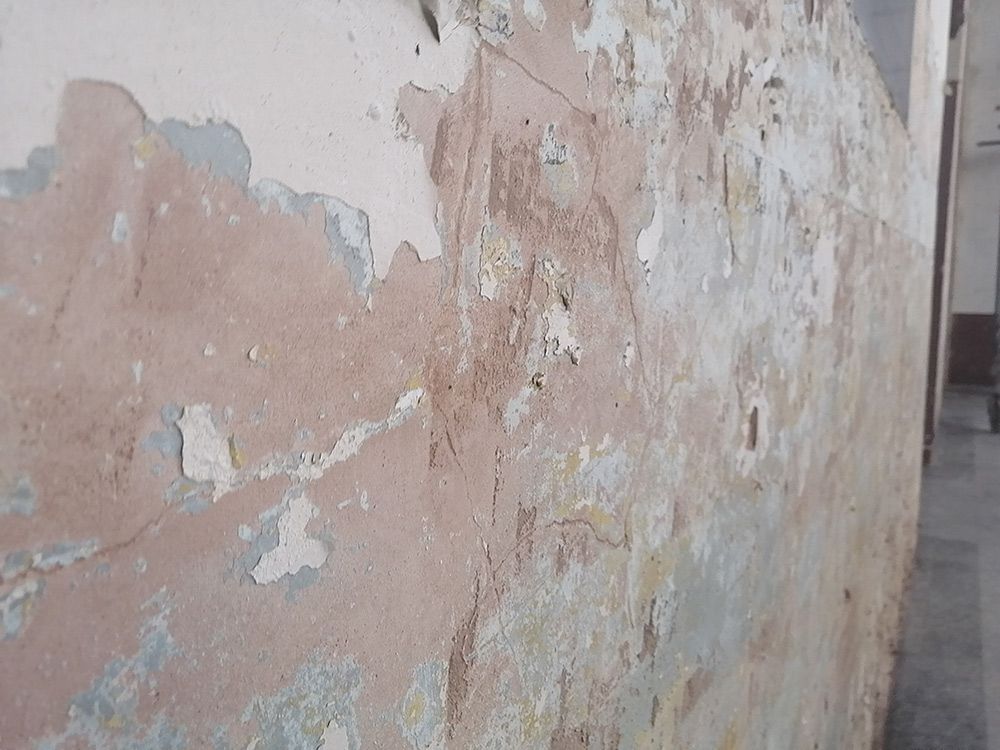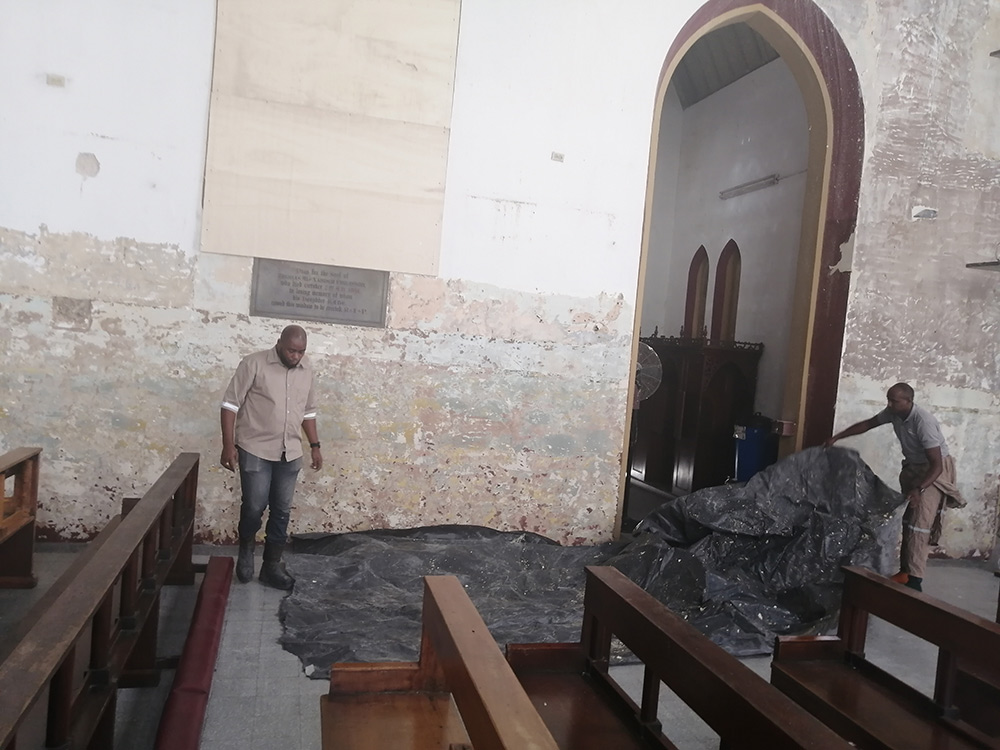The Sacred Heart RC Church is one of Trinidad’s beautiful religious buildings located in downtown Port of Spain near to the Red House, Old Fire Station, Holy Trinity Cathedral and Woodford Square. The church is built in an English Gothic Revival style built of blue limestone from the Laventille Quarries with ballast brick quoins and trims. Throughout the church there are pointed arched stained-glass windows and entrances, with asymmetrical elevations. The original roof of the church consisted of slate tiles and was replaced in the early 1990’s with a sheet metal roof. The architectural plans for this church were drawn out by Louis Auguste de Jacques de La Bastide and the church was completed in 1882.

Main Entrance of the Sacred Heart Church
Blue Limestone became popularly used in Trinidad upon the revamp and development of Port of Spain in the 19th and early 20th century. In 1895 Port of Spain was destroyed by a fire which was allegedly due to an oil lamp breaking in a wooden shop and igniting a fire. At this time all the buildings in the capital were wooden and thus provided fuel for the fire to spread at a speedy pace completely decimating the capital. After this disaster it was decided that wooden buildings were a thing of the past and stone was the new order, specifically blue limestone.
This newly implemented building material was seen as a malleable and durable alternative. It was extracted from the Laventille Quarries in slabs, then transported to the building sites where stonemasons would work the material by cutting and trimming the slabs into smaller cuts and setting them on the buildings (usually without mortar) like puzzle pieces. It was used in many of our famous buildings such as the, Cathedral of Immaculate Conception, All Saint’s Anglican Church, Killarney (Stollmeyer’s Castle), The President’s House (Governor’s Residence) to name a few. These sites which are composed of limestone are unique, in that, they cannot be treated like just another building composed of less delicate materials. The mortar binding the stone together is called lime mortar which isvery different from the modern Portland cement we use in buildings today. Therefore these buildings require certain treatments and care in order to remain in good condition.
As time passes, the knowledge of how to handle materials such as limestone and lime mortar is less common resulting in the inaccurate handling of lime mortar buildings. Latex paint is a common offender used on Lime mortar buildings as the owners of the heritage site may not realise the harm this type of paint can cause to the integrity of the stone. Lime mortar walls are breathable, meaning the lime walls require an airflow through their pores in order to release vapour. If the pores of the wall are blocked the vapour cannot be released resulting in the vapour condensing internally and eventually saturating the stone with moisture which causes serious structural issues. Lime mortar cannot handle latex paint because this type of paint blocks the airflow to the stone, eventually stifling the lime and causing it to disintegrate and crumble.

Interior of the Church
The Sacred Heart RC Church is currently undergoing restoration in order to remove layers of latex paint applied to the walls of the church over the years. Oil paint was also found as one of the layers. This is another common offender as it is not a breathable material and creates a similar negative effect on lime walls. The latex paint on the walls started to bubble on the upper and lower portions throughout the church so the next step from there is to remove the paint.

Pieces of Latex paint can be seen on the lime wall as removal process is underway
Parvenir Heritage Restoration and Maintenance Company is currently responsible for the removal of the latex paint throughout the church. This company focuses on restoring and providing maintenance for heritage buildings and sites of historical and cultural value. They also provide workshops in built heritage conservation & specialist craftsmanship. Lead by their Managing Director, Justin Charles, who founded the company, Parvenir will be restoring the Sacred Heart Church through the removal of the latex paint. The church will not be closed during this restoration process as the mass schedule is still running in conjunction with the restorative works.
To see one of Trinidad’s beautiful Roman Catholic churches in the restorative process, was an eye opening experience. It confirmed that the maintenance of tangible heritage needs to be a more popular conversation especially among owners of heritage sites which require specific care. The stripping of the paint on the walls is an insanely tedious process which requires the utmost care so as not to damage the walls any further. Upon seeing the Parvenir staff undergo the stripping process of the walls, my appreciation for heritage professionals who focus on the health and maintenance of heritage buildings and are knowledgeable of these materials increased tenfold.

Justin Charles (left) with fellow Parvenir employee (right) in the interior of the church laying out a mat to catch Latex paint as removal is in process
For similarly built buildings, the proper materials or finishers to use on lime mortar walls are, lime wash, lime paint, and other lime products which come in many tones and colours. These products will allow the limestone to breathe encouraging airflow throughout the pores of the stone. Products like these can be sourced directly from Parvenir.
Parvenir owner, Justin Charles, urges anyone who owns or manages a heritage site or similarly built building to contact the National Trust of Trinidad and Tobago for any guidance with the maintenance of their heritage site. The National Trust of Trinidad and Tobago is a heritage organisation which can offer advice or direct you to heritage professionals who are knowledgeable in the accurate techniques and practices necessary for the maintenance of a heritage site. Having a regular maintenance program is a beneficial practice if you own a heritage site as this can circumvent any major issues which can become large expenses in the future.
Author: Maya Doyle
References
Angelo Bissesarsingh (Virtual Museum)
Book of Trinidad (Bessos & Brereton)
Video interview : Justin Charles, Managing Director of Parvenir

